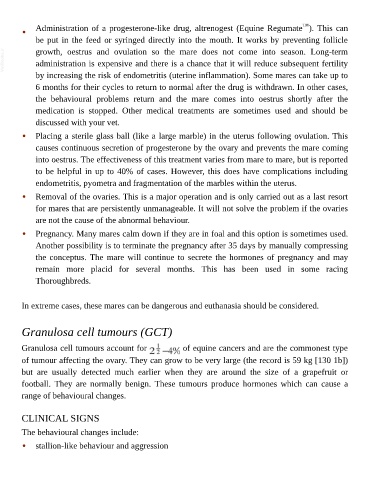Page 1029 - The Veterinary Care of the Horse
P. 1029
™
• Administration of a progesterone-like drug, altrenogest (Equine Regumate ). This can
be put in the feed or syringed directly into the mouth. It works by preventing follicle
VetBooks.ir growth, oestrus and ovulation so the mare does not come into season. Long-term
administration is expensive and there is a chance that it will reduce subsequent fertility
by increasing the risk of endometritis (uterine inflammation). Some mares can take up to
6 months for their cycles to return to normal after the drug is withdrawn. In other cases,
the behavioural problems return and the mare comes into oestrus shortly after the
medication is stopped. Other medical treatments are sometimes used and should be
discussed with your vet.
• Placing a sterile glass ball (like a large marble) in the uterus following ovulation. This
causes continuous secretion of progesterone by the ovary and prevents the mare coming
into oestrus. The effectiveness of this treatment varies from mare to mare, but is reported
to be helpful in up to 40% of cases. However, this does have complications including
endometritis, pyometra and fragmentation of the marbles within the uterus.
• Removal of the ovaries. This is a major operation and is only carried out as a last resort
for mares that are persistently unmanageable. It will not solve the problem if the ovaries
are not the cause of the abnormal behaviour.
• Pregnancy. Many mares calm down if they are in foal and this option is sometimes used.
Another possibility is to terminate the pregnancy after 35 days by manually compressing
the conceptus. The mare will continue to secrete the hormones of pregnancy and may
remain more placid for several months. This has been used in some racing
Thoroughbreds.
In extreme cases, these mares can be dangerous and euthanasia should be considered.
Granulosa cell tumours (GCT)
Granulosa cell tumours account for of equine cancers and are the commonest type
of tumour affecting the ovary. They can grow to be very large (the record is 59 kg [130 1b])
but are usually detected much earlier when they are around the size of a grapefruit or
football. They are normally benign. These tumours produce hormones which can cause a
range of behavioural changes.
CLINICAL SIGNS
The behavioural changes include:
• stallion-like behaviour and aggression

